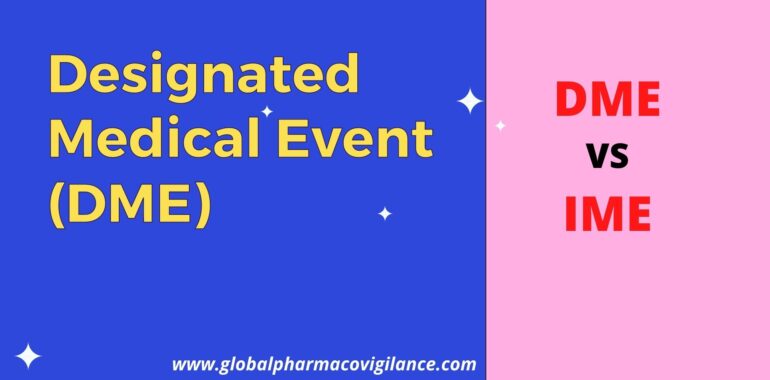Designated Medical Event (DME)

Designated Medical Event (DME)
Designated Medical Event (DME)
European Medicines Agency has developed the Designated Medical Event (DME) list to help to prioritize the review of reports of suspected Adverse Drug Reactions (ADRs) in the framework of the day-to-day pharmacovigilance activities.
This is used by the European Medicines Agency, as well as the EEA Member States, to identify reports of suspected ADRs that deserve special attention, irrespective of statistical criteria used to prioritise safety reviews.
Therefore, the DME list serves as a safety net to ensure that signals are not missed.
The list includes MedDRA Preferred Terms that identify serious medical concepts often causally associated with drugs across multiple pharmacological/therapeutic classes.
It may not address product-specific issues, and conditions with high prevalence in the general population are excluded.
The content of the DME list is not definitive and may change as further experience with its use is gathered.
The DME list is published for transparency purposes only.
Designated Medical Event (DME) list
The current Designated Medical Event (DME) list as follows (15-06-2020)
| Acute hepatic failure |
| Acute kidney injury |
| Agranulocytosis |
| Anaphylactic reaction |
| Anaphylactic shock |
| Anaphylactoid reaction |
| Anaphylactoid shock |
| Angioedema |
| Aplasia pure red cell |
| Aplastic anaemia |
| Autoimmune haemolytic anaemia |
| Autoimmune hepatitis |
| Autoimmune pancreatitis |
| Azotaemia |
| Blindness |
| Bone marrow failure |
| Deafness |
| Deafness neurosensory |
| Deafness permanent |
| Deafness transitory |
| Dermatitis exfoliative |
| Dermatitis exfoliative generalised |
| Drug reaction with eosinophilia and systemic symptoms |
| Drug-induced liver injury |
| Erythema multiforme |
| Febrile neutropenia |
| Granulocytopenia |
| Haemolysis |
| Haemolytic anaemia |
| Hepatic failure |
| Hepatic infarction |
| Hepatic necrosis |
| Hepatitis fulminant |
| Immune thrombocytopenia |
| Intestinal perforation |
| Ischaemic pancreatitis |
| Neutropenic colitis |
| Neutropenic infection |
| Neutropenic sepsis |
| Oedematous pancreatitis |
| Optic ischaemic neuropathy |
| Pancreatitis |
| Pancreatitis acute |
| Pancytopenia |
| Product contamination microbial |
| Progressive multifocal leukoencephalopathy |
| Pulmonary arterial hypertension |
| Pulmonary fibrosis |
| Pulmonary hypertension |
| Renal failure |
| Reye’s syndrome |
| Rhabdomyolysis |
| Stevens-Johnson syndrome |
| Sudden cardiac death |
| Sudden hearing loss |
| Sudden visual loss |
| Thrombotic thrombocytopenic purpura |
| Torsade de pointes |
| Toxic epidermal necrolysis |
| Toxic optic neuropathy |
| Transmission of an infectious agent via product |
| Ventricular fibrillation |
Designated Medical Event (DME) (Excel sheet)
DME VS IME
DME and IME are not the same. Both are different.
|
Designated Medical Event (DME)
|
Important medical event (IME) | |
| Definition | DMEs are serious and rare medical events that are often causally associated with drugs across multiple pharmacological/ therapeutic classes. | The EudraVigilance Expert Working Group has co-ordinated the development of an important medical event (IME) terms list based on the Medical Dictionary for Regulatory Activities (MedDRA).
This IME list aims to facilitate the classification of suspected adverse reactions, the analysis of aggregated data and the assessment of ICSRs in the framework of the day-to-day pharmacovigilance activities. The IME list is intended for guidance purposes only and is available on the EMA website to stakeholders who wish to use it for their pharmacovigilance activities. It is regularly updated in line with the latest version of MedDRA. |
| Relevance | DMEs are serious, rare and often causally associated with drugs. Therefore, even small number of reports of such event can trigger a signal and require special attention.
Organisation may maintain such list, to prioritise cases of such event for safety review. EMA maintains a list MedDRA Preferred Terms that identifies DMEs. The content of the EMA DME list is not definitive and may change as EMA gathers further experience with its use. |
IME list can be used to facilitate seriousness assessment of AEs. |